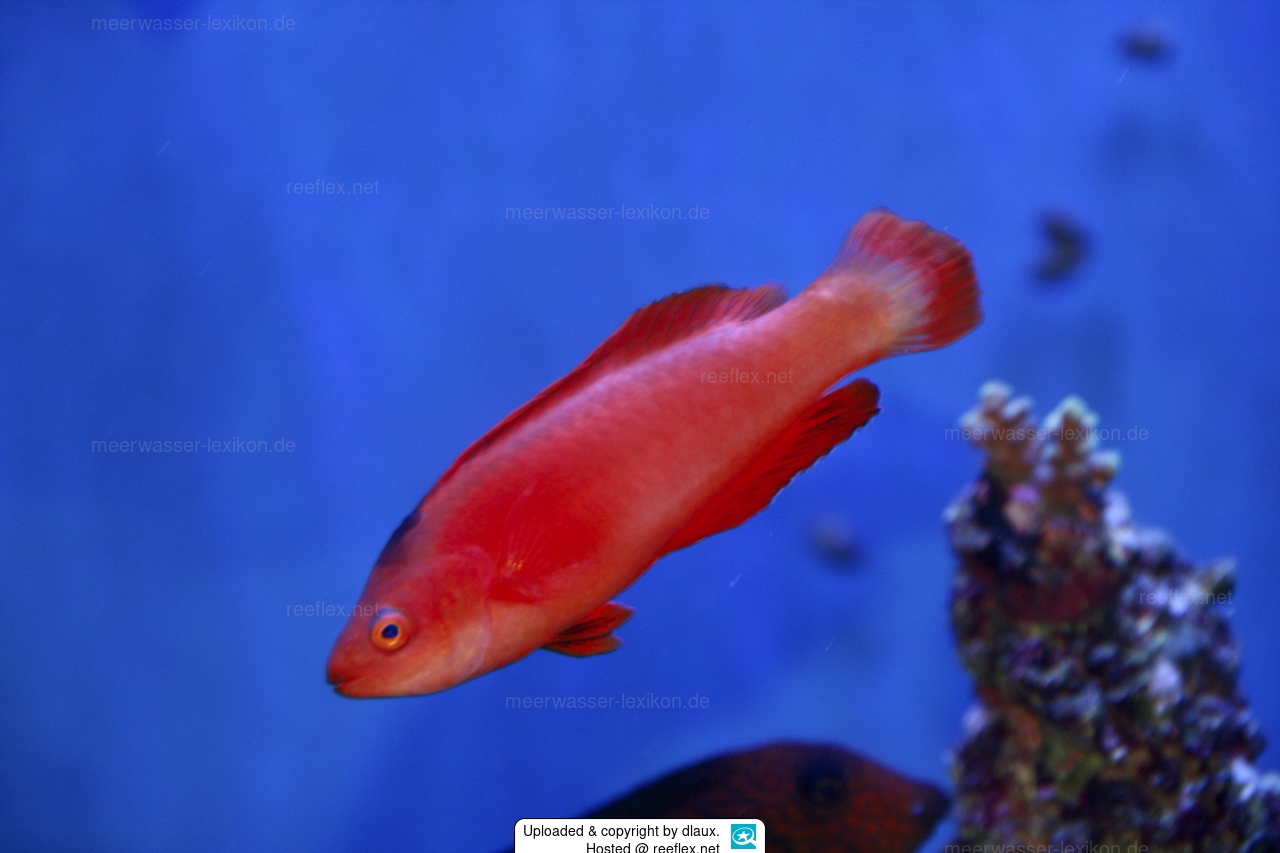Info
Very special thanks for the first photo of the amasing "Magma wrasse" or " Cherry Fairy Wrasse" to Barnett P Shutman RVS Fishworld, Inc. (Philippines).
The Cherry Fairy Wrasse is a new species of Cirrhilabrus which has just been discovered in the Philippines. The new fairy wrasse is wildly distinct from any known species of Cirrhilabrus, but shares a few similarities with some common, popular marine aquarium species.
The new Cherry Fairy Wrasse was discovered by R.V.S. Fishworld, adding one more trophy onto their streak of discoveries. As if the Philippines needed any more reason to put itself back on our fishy radar, the photos of this new fairy wrasse definitely turned a lot of heads in the reefing and ichthyology world.
The Cherry Fairy Wrasse was found in an extreme northern part of the filipino islands, a four to five hour boat ride from Santa Ana, where R.V.S. has previously struck gold many times before already. More specifically, the new fairy wrasse was collected at Balintang Island next to Didicas Volcano at the profound depth of 180 to 280 feet, where the fish are found swimming pretty close to the reef structure.
This newfound wrasse is a gorgeous red overall, with a splash of yellow at the base of the tail, and an anal fin which is even deeper crimson in the anal fin. There’s a hint of a black spot on the head right before the dorsal fin, but otherwise this Cirrhilabrus is about as red as a reef fish can get.
Another fairy wrasse which is almost this red overall, but not quite, is the flame wrasse, Cirrhilabrus jordani, and this is the species that the new cherry fairy wrasse most closely resembles. The shape of this fish, plus its coloration and overall unadorned fins, all suggest that this fish is probably most closely related to the flame wrasse.
Besides the overall coloration, those weird short and stubby pelvic fins are especially reminiscent of the flame wrasse, except in Cirrhilabrus jordani the pelvic and anal fins are much closer together, touching almost. Together this set of features really distinguishes this species from pretty much all other fairy wrasses, and there is no doubt that this fish will turn out to be a wholly new species when it is prepared for official description by Dr. Gill and Yi-Kai Tea later this year.
Source: Reef Builders
Classification: Biota > Animalia (Kingdom) > Chordata (Phylum) > Vertebrata (Subphylum) > Gnathostomata (Superclass) > Pisces (Superclass) > Actinopteri (Class) > Perciformes (Order) > Labroidei (Suborder) > Labridae (Family) > Cirrhilabrus (Genus)
Jumping guard
A jumping guard prevents (nocturnal) fish from jumping out.
Wrasses, blennies, hawkfishs and gobies jump out of an unprotected tank in fright if their night rest is disturbed, unfortunately these jumpers are found dried up in the morning on carpets, glass edges or later behind the tank.
https://www.korallenriff.de/en/article/1925_5_Jump_Protection_Solutions_for_Fish_in_the_Aquarium__5_Net_Covers.html
A small night light also helps, as it provides the fish with a means of orientation in the dark!
The Cherry Fairy Wrasse is a new species of Cirrhilabrus which has just been discovered in the Philippines. The new fairy wrasse is wildly distinct from any known species of Cirrhilabrus, but shares a few similarities with some common, popular marine aquarium species.
The new Cherry Fairy Wrasse was discovered by R.V.S. Fishworld, adding one more trophy onto their streak of discoveries. As if the Philippines needed any more reason to put itself back on our fishy radar, the photos of this new fairy wrasse definitely turned a lot of heads in the reefing and ichthyology world.
The Cherry Fairy Wrasse was found in an extreme northern part of the filipino islands, a four to five hour boat ride from Santa Ana, where R.V.S. has previously struck gold many times before already. More specifically, the new fairy wrasse was collected at Balintang Island next to Didicas Volcano at the profound depth of 180 to 280 feet, where the fish are found swimming pretty close to the reef structure.
This newfound wrasse is a gorgeous red overall, with a splash of yellow at the base of the tail, and an anal fin which is even deeper crimson in the anal fin. There’s a hint of a black spot on the head right before the dorsal fin, but otherwise this Cirrhilabrus is about as red as a reef fish can get.
Another fairy wrasse which is almost this red overall, but not quite, is the flame wrasse, Cirrhilabrus jordani, and this is the species that the new cherry fairy wrasse most closely resembles. The shape of this fish, plus its coloration and overall unadorned fins, all suggest that this fish is probably most closely related to the flame wrasse.
Besides the overall coloration, those weird short and stubby pelvic fins are especially reminiscent of the flame wrasse, except in Cirrhilabrus jordani the pelvic and anal fins are much closer together, touching almost. Together this set of features really distinguishes this species from pretty much all other fairy wrasses, and there is no doubt that this fish will turn out to be a wholly new species when it is prepared for official description by Dr. Gill and Yi-Kai Tea later this year.
Source: Reef Builders
Classification: Biota > Animalia (Kingdom) > Chordata (Phylum) > Vertebrata (Subphylum) > Gnathostomata (Superclass) > Pisces (Superclass) > Actinopteri (Class) > Perciformes (Order) > Labroidei (Suborder) > Labridae (Family) > Cirrhilabrus (Genus)
Jumping guard
A jumping guard prevents (nocturnal) fish from jumping out.
Wrasses, blennies, hawkfishs and gobies jump out of an unprotected tank in fright if their night rest is disturbed, unfortunately these jumpers are found dried up in the morning on carpets, glass edges or later behind the tank.
https://www.korallenriff.de/en/article/1925_5_Jump_Protection_Solutions_for_Fish_in_the_Aquarium__5_Net_Covers.html
A small night light also helps, as it provides the fish with a means of orientation in the dark!







 dlaux
dlaux
















































































